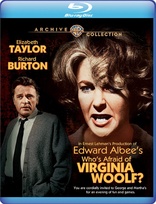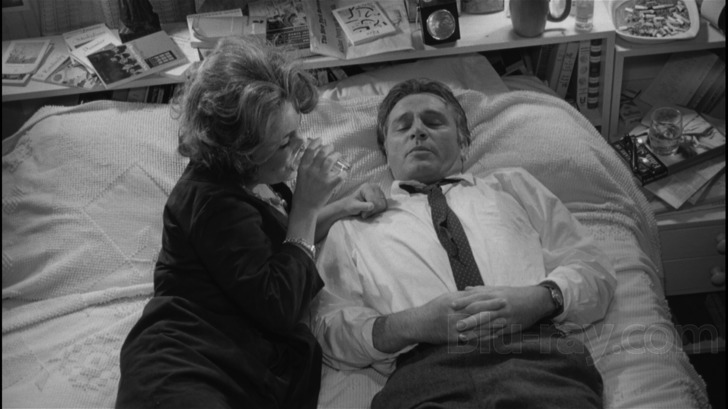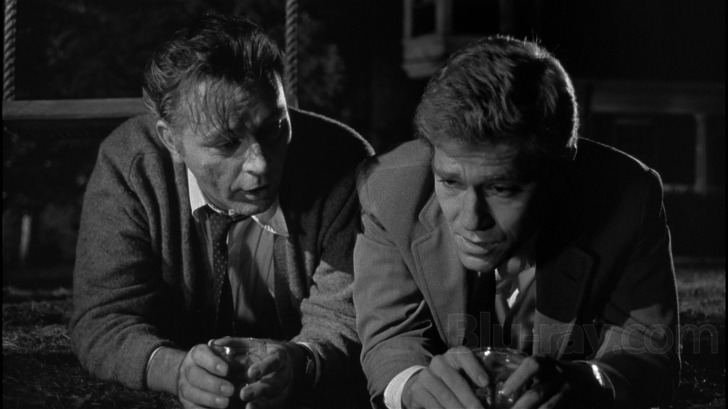Who's Afraid of Virginia Woolf? Blu-ray Movie
HomeWho's Afraid of Virginia Woolf? Blu-ray Movie 
Warner Archive CollectionWarner Bros. | 1966 | 131 min | Not rated | May 03, 2016

Movie rating
7.9 | / 10 |
Blu-ray rating
| Users | 1.5 | |
| Reviewer | 5.0 | |
| Overall | 4.3 |
Overview
Who's Afraid of Virginia Woolf? (1966)
Martha and her professor husband, George, invite a younger couple for drinks after a faculty party.
Starring: Elizabeth Taylor, Richard Burton, George Segal, Sandy Dennis, Frank FlanaganDirector: Mike Nichols (I)
| Drama | 100% |
Specifications
Video
Video codec: MPEG-4 AVC
Video resolution: 1080p
Aspect ratio: 1.77:1
Original aspect ratio: 1.85:1
Audio
English: DTS-HD Master Audio 2.0 Mono (48kHz, 24-bit)
French: Dolby Digital 2.0 Mono (192 kbps)
German: Dolby Digital 2.0 Mono
Spanish: Dolby Digital 2.0 Mono (192 kbps)
Spanish: Dolby Digital 2.0 Mono (192 kbps)
Czech: Dolby Digital 2.0 Mono
Polish: Dolby Digital 2.0 Mono
Japanese: Dolby Digital 2.0 Mono
BDInfo & PowerDVD corrected. All other tracks are (192 kbps). Spanish=Latin & Castillian; Japanese is hidden
Subtitles
English SDH, French, German SDH, Japanese, Spanish, Czech, Korean, Polish, Romanian, Thai, Turkish
Discs
50GB Blu-ray Disc
Single disc (1 BD)
Playback
Region free
Review
Rating summary
| Movie | 5.0 | |
| Video | 5.0 | |
| Audio | 5.0 | |
| Extras | 4.5 | |
| Overall | 5.0 |
Who's Afraid of Virginia Woolf? Blu-ray Movie Review
Funny Games
Reviewed by Michael Reuben April 26, 2016There are many reasons why Who's Afraid of Virginia Woolf? is a landmark film. It was the first
feature directed by Mike Nichols, inaugurating a career that would encompass The Graduate,
The Birdcage and Carnal Knowledge. It was the first film to have its entire credited cast
nominated for Oscars and the second in history to be nominated in every category for which it
was eligible (thirteen in all, with five wins). It ushered in a new era of frankness in Hollywood's
treatment of mature subject matter, dealing a death blow to the Production Code (often called
"the Hays Code") that had governed America's screens since 1930. It was the first film to carry
an explicit warning that no one under 18 would be admitted without an accompanying adult.
Statistics aside, though, Virginia Woolf remains a vital work today, fifty years after its initial
release, because an unlikely group of collaborators successfully translated Edward Albee's
original play to the screen with the same furious intensity that first electrified audiences in 1962.
Albee's play continues to be revived, restaged and reinterpreted (twice on Broadway in the last
twelve years), but Nichols' film has become an essential part of the drama's lore. No other
classic of the American stage has received a more effective translation to the screen.
For Virginia Woolf's fiftieth anniversary, the Warner Archive Collection has rescanned and
restored the film for Blu-ray and accompanied it with the wealth of extras assembled for the 2006
DVD special edition.

At the most basic level, Virginia Woolf is a portrait of two marriages—or perhaps it would be more accurate to call it an excavation. The action plays out over one late Saturday night and early Sunday morning at an unnamed university in a fictional New England town. (The production used Smith College for exteriors.) A couple in their fifties, George and Martha (Richard Burton and Elizabeth Taylor), walk home across the campus after a faculty party. Martha, the more aggressive drinker of the pair, is staggering.
The opening scenes provide a first look at the couple's complex marriage. George is an Associate Professor of History (and only an Associate Professor, as his wife repeatedly reminds him), while Martha is the daughter of the university's president. She married George when he appeared to be a rising star in academia. Life has disappointed them both, but they are partners in disenchantment, filling their days and nights with barbs, banter and, yes, affection. Martha will later confide to a near-stranger that George is the only man she has ever loved. George, who initially appears to be beaten down by his wife's brassy extroversion, will gradually reveal hidden reserves of wily aggression. The fact that the couple bears the same names as America's founding President and First Lady is an intentional irony.
On this night, though, the delicate balance (to borrow another Albee title) that keeps the marriage of George and Martha poised on the edge of mutual tolerance is upset by the arrival of another couple, Nick and Honey (George Segal and Sandy Dennis). He is a new addition to the faculty, a member of the Biology Department, although Martha mistakenly thinks he's in math and, as George immediately suspects, she doesn't particularly care what subject he teaches but only that he's young and handsome. Honey is his dutiful wife who, from the moment they appear onscreen, seems mismatched with this former quarterback and current golden boy of the sciences. Despite the late hour, Martha has invited the couple to join her and George for drinks, and Nick and Honey obey because Martha is, after all, the president's daughter.
With Honey and Nick as her audience, and fueled by continuous drinking, Martha rapidly exceeds the customary boundaries of the loaded repartee with which she and George pass their hours. She pushes him too hard, says too much and lurches into prohibited topics like the couple's absent son. As George rises to the provocation, the evening turns violent: not so much physical violence (although that, too, occurs, improbably cheered on by an intoxicated Honey) but an emotional blitzkrieg waged by two highly articulate individuals who know each other's weak spots intimately. Nick and Honey are initially uncomfortable and bewildered by the maelstrom into which they have blundered, but they are helpless to resist, becoming pawns in the high-stakes match between their hosts. With the practiced eye of experienced combatants, Martha and George (particularly George) sniff out the younger couple's weaknesses and hammer on the fractures in their marriage. Secrets are revealed, lies exposed, and at some point in the evening, each partner betrays the other. Like the original play, the film leaves the viewer to decide how (or whether) each couple will find their way forward after their parting at dawn.
The script of Virginia Woolf is officially credited to Ernest Lehman (Sweet Smell of Success), who, as Albee later commented, wrote "about twenty-five words". Indeed, Nichols rejected Lehman's script, which changed the ending, and returned to Albee's original text. With trims for running time and a few substituted words to satisfy the concerns of the MPAA, Virginia Woolf is heard in the film just as Albee wrote it. Freed from the stage's spatial constraints, Nichols' camera roams throughout George's and Martha's house—the play is confined to their living room—ventures into the front and back yard and, in a controversial decision, follows the foursome to a roadside bar for dancing, more drinks and several of the night's most brutal confrontations. Nichols and cinematographer Haskell Wexler use deep focus, odd angles and carefully selected closeups to pull viewers into the fray and give the escalating conflicts a visceral immediacy. (Albee, who generally approved of the film, complained that it lost the "intellectual" level of his text, but it's there if you look for it.)
The casting of Taylor and Burton raised eyebrows at the time (including Albee's), not only due to the stars' own tempestuous marriage, but also because Taylor, at 32, was twenty years younger than her character. Under Nichols' direction, however, both actors deliver career-best performances. Burton speaks George's literate dialogue with naturalistic ease, free of the thespian mannerisms on which he would fall back later in his career, as his own drinking sapped his gifts. Taylor's Martha was (and remains) a revelation. Gaining thirty pounds, aging herself with hair and makeup, and shedding every trace of the glamorous movie star who dominated the era's gossip columns, the actress conveys Martha's anger, her cruelty and her desperate need for love with an emotional transparency that is both terrifying and painful. When George accuses her of being a monster, Martha famously replies: "I'm loud and I'm vulgar, and I wear the pants in the house because somebody's got to, but I am not a monster. I'm not!"—and Taylor's delivery is so fraught that she conveys both Martha's furious denial and her frightened suspicion that a monster is exactly what she's become. (Nichols has said that, no matter how good Taylor's performance seemed on the set, when he saw it on film, it was ten times better.)
Who's Afraid of Virginia Woolf? Blu-ray Movie, Video Quality 

The original cinematographer for Who's Afraid of Virginia Woolf?, Harry Stradling, Sr.
(Suspicion) was fired during pre-production and
replaced by Haskell Wexler (Bound for Glory),
who won an Oscar for the film's expressive black-and-white images. Accordingly to Wexler,
Stradling lost the job after telling director Mike Nichols that he hated Fellini's 8½ , whose style
Nichols wanted to emulate.
Virginia Woolf was made in an era when release prints were indiscriminately struck directly from
the original camera negative, which had sustained significant damage by the time the studio
began its film preservation efforts many years later. Those efforts led to the creation of a fine-grain master
positive, which Warner's MPI facility has newly scanned (at 2K) for this 1080p, AVC-encoded
Blu-ray. Substantial restoration was performed in the digital domain to repair damage and
remove dirt and scratches.
The Blu-ray image is superb. Wexler's lighting creates a sense of depth that is essential to
Nichols' expressive arrangement of the characters in physical space. The solid blacks, well-delineated shades of gray and finely rendered film grain
reveal exceptional detail throughout
George's and Martha's unkempt home in a decaying campus house, where Richard Sylbert's
Oscar-winning production design tells you as much about their marriage as Albee's dialogue.
(When Martha famously declares the place a "dump", you can see just what she means.) Faces
are vividly displayed, revealing tiny flickers of reaction and shifts of emotion. Some of Wexler's
shots are almost painterly in their rendering of mood (e.g., the long shot of George sitting alone
on a swing; see screenshot #14). Even the pedestrian decor of the roadhouse location makes a
contribution; its banality contrasts sharply with the events that prompt Honey to squeal
"Violence!" with delight.
Having transferred and restored Virginia Woolf with care, WAC has mastered it on Blu-ray with
its usual high average bitrate of just under 35 Mbps and an excellent encode.
Who's Afraid of Virginia Woolf? Blu-ray Movie, Audio Quality 

Virginia Woolf's mono soundtrack has been restored from the original magnetic tracks and encoded in lossless DTS-HD MA 2.0, with identical left and right channels. The dialogue has been faithfully and clearly rendered, including those portions where Nichols and editor Sam O'Steen deliberately overlapped speakers (a rarity in American films at the time). The track features numerous small sound effects, many of which are meant to register subliminally: the clink of glasses, the rattling of ice cubes, the repeated pouring of drinks. An occasional effect registers forcefully for dramatic purpose (e.g., the ringing of chimes that awakens Honey at the top of the third act, or the sudden lurch of the car when the foursome veers off to the roadhouse). All of these sounds have been artfully layered into the mix to sound like natural occurrences. Alex North (Spartacus) provided the spare score, which contains almost no recurring themes. It's more a collection of individual compositions, each one crafted to a specific moment in the drama.
Who's Afraid of Virginia Woolf? Blu-ray Movie, Special Features and Extras 

Virginia Woolf has appeared on DVD multiple times, beginning with a 1997 release that included
a commentary by Haskell Wexler. That commentary also appeared on the 2006 two-disc edition
assembled for the "Elizabeth Taylor & Richard Burton Film Collection", which added a second
commentary and other new features. The two commentaries were included on a 2010 single-DVD reissue.
For Blu-ray, WAC has ported over all of the extras from the 2006 two-disc edition. It's an
impressive set.
- Commentaries
- With Cinematographer Haskell Wexler: Wexler focuses on the technical details of shooting the film, discussing lights, lenses and exposures and pointing out shots that involved special challenges. He also describes how he was hired (which required abandoning another commitment), discusses his working relationship with Nichols and relates anecdotes about Taylor, Burton and the crew. Near the end of his commentary, which concludes half an hour before the film, Wexler briefly discusses the making of Medium Cool, which he directed.
- With Director Mike Nichols and Steven Soderbergh: Following on their successful collaboration on a DVD commentary for Catch-22, Soderbergh and Nichols discuss both Virginia Woolf and the craft of directing. Nichols discusses his naivete about certain aspects of filmmaking, relates production stories and points out aspects of the film he doesn't like. Soderbergh watches with the eye of a fellow director, focusing on technical points of cinematic craft. Never dull, it's a discussion that enhances one's understanding of the practical day-to-day demands of shooting a film.
- Who's Afraid of Virginia Woolf?: Too Shocking for Its Time (480i; 1.78:1, enhanced; 10:37): Former MPAA head Jack Valenti discusses the controversy over the film's language and subject matter. Other participants include film critic Richard Schickel, film professor Dr. Drew Casper and Bobbie O'Steen, widow of the film's editor.
- Who's Afraid of Virginia Woolf?: A Daring Work of Raw Excellence (480i; 1.78:1, enhanced; 20:14): This featurette provides both a critical overview of Albee's play and a history of its journey to the screen. The participants from the previous featurette reappear, along with Wexler and, of special note, playwright Edward Albee.
- 1966 Mike Nichols Interview (480i; 1.33:1; 9:00): Interviewed by NBC shortly after the film's release, Nichols discusses his directing style, the making of Virginia Woolf and his life and career up to that point.
- Sandy Dennis Screen Test (1080p; 2.35:1; 7:13): A portion of this screen test appears in "A Daring Work of Raw Excellence". Roddy McDowall plays Nick.
- Elizabeth Taylor: Intimate Portrait (480i; 1.33:1; 1:06:31): This original documentary aired on ABC in 1975. Hosted by Peter Lawford, it's an unabashed love letter to the star, including interviews with Rock Hudson, Roddy McDowall, director Richard Brooks and Taylor's mother, Sara.
- Trailers
- The Comedians (480i; 1.33:1; 1:24)
- The Sandpiper (480i; 1.85:1; 3:24)
- The V.I.P.s (480i; 2.35:1; 4:06)
- Who's Afraid of Virginia Woolf? (1080p; 1.78:1; 2:13)
Who's Afraid of Virginia Woolf? Blu-ray Movie, Overall Score and Recommendation 

"Who's afraid of Virginia Woolf?" is a line that Albee once saw written in soap on the mirror
behind a bar. It struck him as "a rather typical university, intellectual joke", and years later he
incorporated it into a play set at a university, attributing the gag to an unidentified attendee at the
party preceding the action and later repeated by Martha, who finds it hilarious. (In the film as in
many stage productions, it is sung to the tune of "Here We Go 'Round the Mulberry Bush",
which is in the public domain, as opposed to "Who's Afraid of the Big Bad Wolf?", which must
be licensed from Disney.) Much ink has been spilled attempting to identify deep meaning in the
joke's literary reference, but it resists any definitive interpretation, which, I suspect, is why it
appealed to Albee. By the end of Virginia Woolf, the laughter has vanished. Only the fear
remains. Highest recommendation.
Similar titles
Similar titles you might also like

A Raisin in the Sun
1961

The Servant
1963

The Magician
Ansiktet
1958

Persona
1966

Interiors
1978

Black Narcissus
1947

The Passion of Anna
En passion
1969

A Woman Under the Influence
1974

The Silence
Tystnaden
1963

Through a Glass Darkly
Såsom i en spegel
1961

The Rite
Riten / The Ritual
1969

The Power of the Dog
2021

Aparajito 4K
অপরাজিত / The Unvanquished
1956

Krisha
Signed Limited Edition to 100 Copies - SOLD OUT
2015

Clouds of Sils Maria
2014

Master of the House
Du skal ære din hustru
1925

Phoenix
2014

The Night Porter
Il portiere di notte
1974

Taste of Cherry
طعم گيلاس / Ta'm e guilass
1997

Like Someone in Love
ライク・サムワン・イン・ラブ / Raiku samuwan in rabu
2012